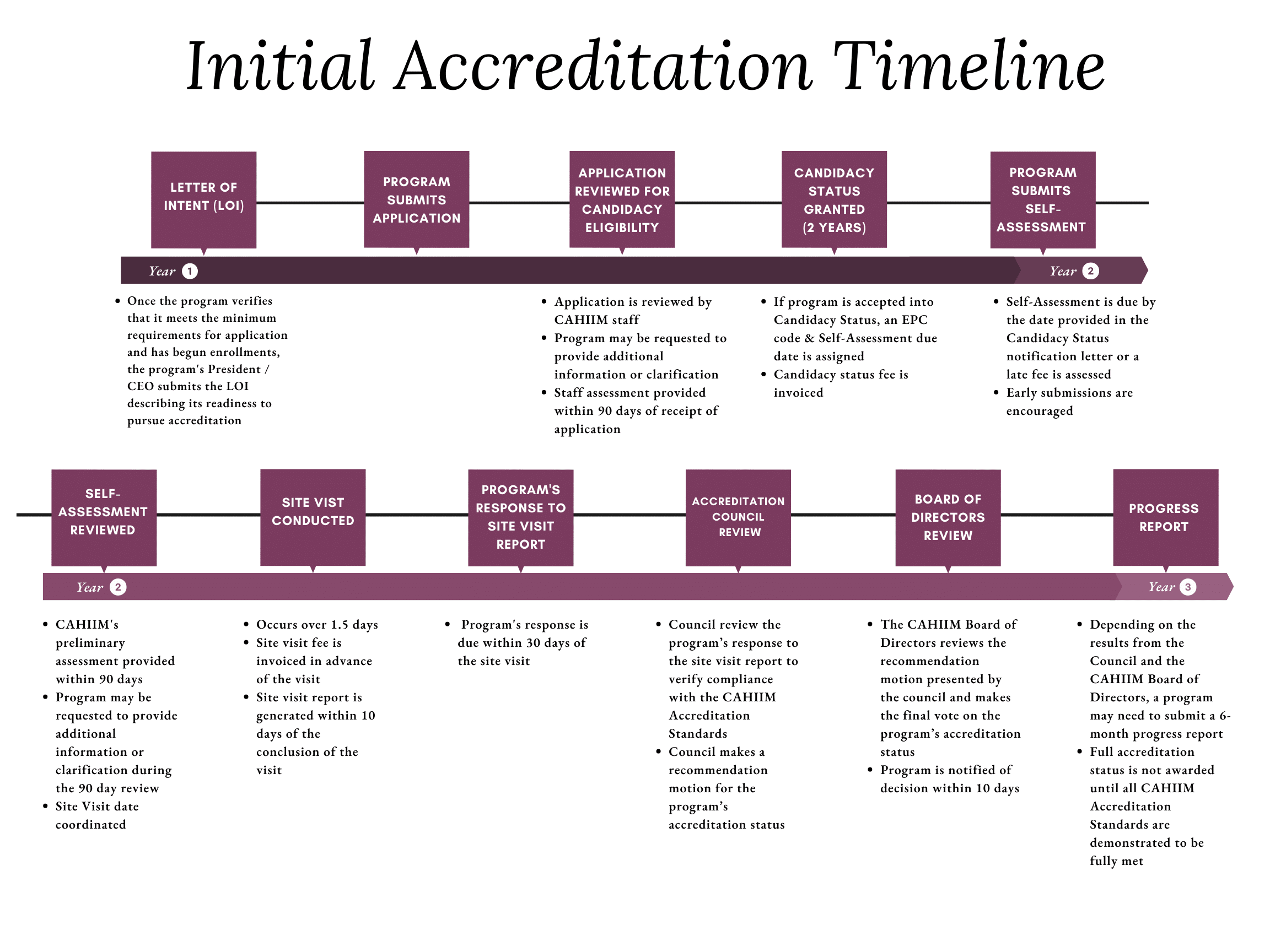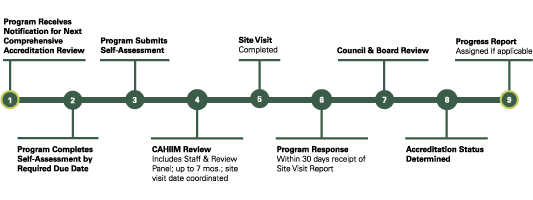Health Informatics
Health informatics is an interdisciplinary, evolving science at the intersection of health and healthcare, information science and technology, and social/behavioral science, using data, information, and knowledge to improve individual and population health and manage healthcare operations.
Through intelligent data use, health informatics develops, deploys, analyzes, and manages a variety of applications (e.g., EHRs, clinical decision support, documentation, order entry systems, telehealth, health information exchange, mHealth apps) to improve healthcare outcomes and engage consumers.
Health informatics applies to patient care, public health and policy, education, and health sciences research.
Health Informatics Accreditation (CHEA-Recognized)
Health Informatics education occurs in academic programs awarding baccalaureate, masters, and professional doctoral degrees. The master’s degree has a set of Accreditation Standards that ensure the quality of the education. Standards for the baccalaureate and professional doctorate are under development. Students entering these programs come from a variety of backgrounds, e.g., engineering, computer science, healthcare, and others. Education may also occur as a specialty within clinical degree programs, e.g., medicine, nursing, pharmacy, public health, dentistry, and others. CAHIIM considers informatics to be health informatics when used for healthcare delivery to be essentially the same regardless of the group involved.
Clinical Informatics is concerned with information use in health care by clinicians. Clinical informatics includes a wide range of topics ranging from clinical decision support, visual images, clinical documentation, provider order entry systems, information system design, information system implementation, and information system adoption issues.
Health Informatics professionals may practice in health care delivery, health information systems and imaging industry, health informatics education programs, and health informatics standards and policy development.
AMIA Scholarship
AMIA Scholarship
Through its collaboration with the American Medical Informatics Association (AMIA), CAHIIM is pleased to offer the opportunity for qualified master’s programs in health informatics to apply for a scholarship that covers the costs associated with applying for CAHIIM accreditation. Funded by AMIA, the scholarship will cover the application fee, candidacy fee, and site visit fee. Before applying, programs should ensure they meet the professional curriculum content and quality standards outlined in the Health Informatics Accreditation Standards. If awarded a scholarship, the program must be prepared to begin the accreditation process upon notification and complete the process within the specified timeline. Please refer to the timeline on the website for more information.
Up to four scholarships will be awarded in 2025 to qualified programs. More information about the accreditation process, including the accreditation timeline and the Health Informatics Accreditation Standards, can be found on this website.
Eligibility Information
- The sponsoring institution must be accredited by a regional or national accrediting institutional agency recognized by the U.S. Department of Education (USDE). The institution must be authorized to award the graduate- level degree.
- The health informatics program must be established as a core concentration or specialized track within a graduate-level program of study that culminates in a master’s degree.
- The Program Director must be a full-time employee of the institution and have a PhD or equivalent degree.
- The program must clearly define the roles and responsibilities of the faculty necessary to fully support and sustain it.
- The program must demonstrate that financial resources are sufficient to support and maintain it.
- All courses in the program should be implemented and taught prior to applying for the scholarship.
- The program must meet the Health Informatics Accreditation Standards. Please review the Standards to confirm that eligibility requirements are met before applying. https://www.cahiim.org/accreditation/health-informatics/
- Programs that have applied for CAHIIM accreditation and have been accepted into candidacy are ineligible to apply for the scholarship.
- Programs that previously applied for CAHIIM accreditation but did not complete the application or had their application denied are also ineligible to apply for the scholarship.
Application Information
Please follow the instructions outlined on the website for initial accreditation and provide the documents listed below.
1. Letter for Scholarship Consideration
A letter explaining why the program should be considered for the scholarship, including its readiness to pursue accreditation. The letter should also include:
- Description of support for the program.
- Reasons for the program’s inception or the need for the program.
- Confirmation of state and institutional accreditation to provide the degree-granting program.
- The month and year of the program launch.
- Actual or projected month and year of the first graduating class.
- Name of the program director.
This letter replaces the letter of intent referenced on the CAHIIM website for initial accreditation.
2. Required Documents
- CAHIIM Self Evaluation Tool (CSET)
- Curriculum Vitae for the Program Director
- Completed Synopsis of Curriculum
- Syllabi
- Curriculum Vitae for the Full-Time Faculty Member
Instructions and template for the required documents can be found in the “Initial Accreditation” section, below.
The profile page and credentialing disclaimer do not need to be completed at this time.
Incomplete applications or those that do not meet the requirements for accreditation will not be considered for the scholarship.
Important Application Deadlines
Completed applications must be received by November 30, 2025.
Applications will be evaluated by an independent committee of qualified health informatics professionals who are not affiliated with CAHIIM.
Applicants will be notified about the Committee’s decision by January 31, 2026.
Application Information
The scholarship will cover the cost of the application fee, candidacy fee and site visit fee for initial accreditation totaling $16,500.
In addition, programs awarded the scholarship will also receive the following complimentary registrations during the candidacy period:
- Two (2) registrations to the annual CAHIIM Process Conference.
- Two (2) registrations to the annual CAHIIM Fall Summit.
- Fees will also be waived for two qualified candidates to apply for a CAHIIM Fellowship and CAHIIM Badging through the CAHIIM Faculty Fellowship Program and the Faculty Badging Program.
- Scholarship programs can also utilize the CAHIIM Job Posting services free of charge during the candidacy period.
Standards
Health Informatics Accreditation Standards
Health Informatics is an interdisciplinary field that studies and pursues the effective uses of biomedical data, information, and knowledge to improve human health. Health informatics graduate programs focus on information systems, informatics principles, information technology, leadership and professionalism as applied to the continuum of healthcare delivery. Health informatics graduate programs demonstrate uniqueness by offering varied options for practice and/or research.
CAHIIM Health Informatics Accreditation Standards incorporate foundational program components such as Sponsorship, Systematic Planning, Program Autonomy and Governance, Curriculum and Program Resources.
Curriculum Requirements
Health Informatics Competency Driven Education
Programs are encouraged to review their health informatics curriculum and compare current curriculum content with AMIA’s core competencies (Foundational Domains). The AMIA Foundational Domains are intended to be used for health informatics curriculum development and accreditation assessment for masters level graduate education in health informatics education.
For the purposes of CAHIIM Accreditation, students in the health informatics discipline should have working knowledge and competency of these foundational domains as they define and affect the practice of health informatics. The program graduate is expected to demonstrate the knowledge, skills, and attitudes that exist in the following domains:
- Health
- Information Science and Technology
- Social and Behavioral Science
- Health Information Science and Technology
- Human Factors and Socio-technical Systems
- Social and Behavioral Aspects of Health
- Social, Behavioral, and Information Science and Technology Applied to Health
- Professionalism
- Interprofessional Collaborative Practice
- Leadership
As with all other health professions, the work of health informaticians affects the health, safety, and effectiveness of those working and being cared for within the system of health care delivery.
CAHIIM Self Evaluation Tool (CSET)
The CAHIIM Self Evaluation Tool is an Excel workbook that is used for CAHIIM program curriculum assessment. It is a mapping document that describes what is learned and observed in a Masters of Health Informatics program. The CSET also includes a heat map that will allow the program to see what their areas of concentration/focus are in the AMIA’s Foundational Domains.
The CAHIIM Self Evaluation Tool is required for the CAHIIM application and used to assess the program curriculum once the program is in Candidacy for CAHIIM accreditation.
Website Requirements
Website Publication Requirements
Public Disclosure Policy (see CAHIIM Accreditation Manual)
CAHIIM Accreditation Standards require that all accredited programs make available to the public
- Their location and accreditation status.
- Admissions policies and procedures.
- Policies on advanced placement, transfer of credits, and credits for experiential learning.
- Number of credits required for completion of the program.
- Tuition/fees and other costs required to complete the program.
- Policies and procedures for withdrawal and for refunds of tuition/fees.
- Academic calendar.
- Student grievance procedure.
- Criteria for successful completion of each segment of the curriculum and graduation.
The program and its sponsoring educational institution must accurately represent this information and ensure that the information is published and accessible to all applicants and enrolled students.
Programs accredited by CAHIIM must also use the prescribed CAHIIM Accreditation Statement in all materials and online resources that refer to the program’s accreditation status:
The (HEALTH INFORMATION MANAGEMENT/HEALTH INFORMATICS) accreditor of [COLLEGE NAME] is the Commission on Accreditation for Health Informatics and Information Management Education (CAHIIM). The College’s accreditation for [ASSOCIATE/BACCALAUREATE/MASTER] degree in (HEALTH INFORMATION MANAGEMENT/HEALTH INFORMATICS) has been reaffirmed through [YEAR OF NEXT ACCREDITATON CYCLE]. All inquiries about the program’s accreditation status should be directed by mail to CAHIIM, 200 East Randolph Street, Suite 5100, Chicago, IL, 60601; by phone at (312) 235-3255; or by email at info@cahiim.org. The Accreditation Statement must also include the CAHIIM Seal graphic in the form provided by CAHIIM.
The CAHIIM Seal is registered in the U.S. Patent and Trademark Office. The Seal is for accredited program use only and is to be used for announcements and published statements of accredited status. Use by programs in Candidacy status or non-accredited status is prohibited. It must be used in its entirety and not modified other than in size. Use of any other CAHIIM logo is prohibited. Use of the seal must be in conjunction with the required Accreditation Statement for Maintaining Accreditation. Accredited programs must document the specific recognized campus in all published media. The Seal is available for all accredited programs in the “Resources” tab of the Annual Program Assessment Report (APAR) system. The login permission for the program director in the system allows the Program Directors to access the information. For CAHIIM-accredited programs, the Seal is available in the following formats: png, tif, eps, jpg.
Program and Student Outcome Data
On an annual basis, the program must post the previous year’s program graduation and employment rate, as well as at least one (1) of the following:
i. retention rate
ii. academic transfer
iii. graduate school entry
iv. 4-year undergraduate program entry/ Academic progression rate
v. student satisfaction rate
vi. certification exam pass rate (if applicable)
Outcome data must be as recent as the academic year reported in the most recent Annual Performance and Accountability Report (APAR). The data must specify the year it represents and be posted within one click of the program’s landing page.
Noncompliance
Yearly, CAHIIM conducts a review of all active accredited programs to confirm compliance with the Public Disclosure policy. If the program is noncompliant with the policy, it is granted 14 days to come into compliance without incurring an administrative fee. If the program remains noncompliant after 14 days, an administrative fee will be charged in accordance with the fee schedule.
If, after 65 days, the program’s website remains noncompliant or incomplete, the program is referred to the programmatic Council for deliberation, who may recommend a written report demonstrating corrective actions, or place the program on show cause for pending accreditation actions.
Definitions
CAHIIM does not require programs to use the following definitions, as these will not be applicable to all programs. If a program’s institution defines a particular rate in a different way, the program may use their institutional definition. The following definitions serve as examples.
Graduation rate – the percentage of a school’s first-time, first-year undergraduate students who complete their program within 150% of the published time for the program. For example, for a four-year degree program, entering students who complete within six years are counted as graduates (Definition from FAFSA). This cannot simply be a total number of graduates; it must be a rate.
Employment rate – the percentage of graduates from a program who are employed within a specified time frame. Program must specify the time frame (Ex. Within 6 months of graduation). Generally, graduates pursuing further education are not included in the total. For example: A program with 4 graduates, where 2 gained employment and 2 entered a graduate program would report a 100% (2/2) employment rate. Programs may choose to differentiate employment rate within a related field (healthcare) from the overall employment rate.
Retention rate – the percentage of a school’s first-time, first-year undergraduate students who continue at that school the next year. For example, a student who studies full-time in the fall semester and keeps on studying in the program in the next fall semester is counted in this rate (Definition from FAFSA).
Academic transfer – the percentage of a school’s first-time, first-year undergraduate students who transfer to another college within 150% of the published time for the program. For example, a student who is in a four-year degree program is counted as a transfer if the student goes to another college within six years (Definition from FAFSA).
Graduate school entry rate/4-yr undergraduate program entry – the percentage of a school’s graduates who enter a graduate program upon completion of the program.
4-year undergraduate program entry rate/Academic progression rate – the percentage of a school’s graduates who progress to a 4-year undergraduate program upon completion.
Student satisfaction rate – the percentage of students who have acknowledged satisfaction with their educational experience in the program, based on a student satisfaction survey.
Certification exam pass rate – the percentage of students who tested and passed the applicable certification exam for the program. For example, the pass rate for RHIT (Associate HIM programs) or RHIA (Baccalaureate HIM programs). NOTE: There is currently no applicable certification exam for Health Informatics programs.
Development & Consultation Service
CAHIIM offers assistance and advising service for programs who are in various stages of development and implementation. Paid services are available in developing accreditation and compliance activities toward program improvement.


